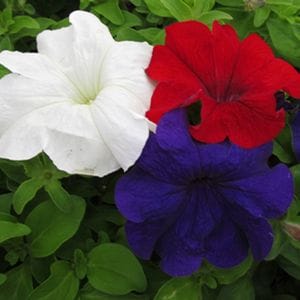Our Average Daily High Temp for July is 82°F
 These are the salad days of summer! Guests at your 4th of July picnics and barbecues will enjoy the harvest from your fruit and vegetable gardens and you can use the cut flowers to decorate your tables, inside and out.
These are the salad days of summer! Guests at your 4th of July picnics and barbecues will enjoy the harvest from your fruit and vegetable gardens and you can use the cut flowers to decorate your tables, inside and out.
Keep deadheading those flowers so they’ll continue to produce blooms, but stop pinching back the chrysanthemums and asters by the 4th. This will allow them enough time to set flower buds for fall blooming. Fertilize every two weeks for heavier blooming.
Now is the perfect time to dig and divide irises. Gently pull and break them apart and discard any mushy rhizomes that may have been infected with iris borers, as well as the oldest rhizomes. Once an iris rhizome has bloomed, it will not produce a flower again. Place them in a shaded area for a day to allow the wound to callous over before replanting. Remember not to totally bury the top of the rhizome when replanting to avoid rotting.
Late in the month, you can start planting a second crop of vegetables for fall harvest, such as beets, carrots, turnips, beans and kohlrabi. Check the seed packets for maturity dates to determine planting times.
Summer is starting to get drier and hotter, so raise the blades on your mower. Allowing your grass to remain a little higher will let it better cope with these conditions. Mowing at a higher level also helps shade out weeds, whose seeds many times need sun to germinate.
Feed annuals about once per month so they will have the energy to keep producing flowers. Feeding flowering container plants at half-strength every two weeks will produce more blooms. Be sure your container plants are getting enough water during this hottest part of summer. They can dry out quickly and some may even need to be watered twice daily.
Continue to add to your compost pile and turn it regularly. Provide supplemental watering if there hasn’t been enough rain to keep things from drying out. Compost needs the moisture for decomposition to take place.
Inspect your tomato plants regularly for hornworms. Look for chewed foliage and black frass (their droppings). Since they do turn into Sphinx moths, which are night pollinators, I break off a piece of the tomato foliage and place it with the worm into the compost bin. You can also treat the tomato plants with Bt (Bacillus thurengiensis). This also works well to control cabbage loopers.
Prune your summer-flowering shrubs now, if they’re done blooming. Remove any diseased or dead branches.
Be sure to clean your hummingbird feeder on a regular basis. The sweet water attracts insects and can become moldy, which isn’t good for the hummingbirds. They’ll soon be feeding heavily as they prepare once again to travel south.
To-Dos:
- Enjoy and share the bounty from your fruit and vegetable gardens.
- Keep deadheading perennials and annuals for continued blooming.
- STOP pinching back your mums and asters by the 4th of July.
- Dig and divide irises by the end of the month and replant.
- At the end of the month, begin planting seeds for fall vegetable crops.
- Raise the blades on your lawn mower for the health of your grass.
- Continue to feed annuals and make sure container plants have plenty of water.
- Turn your compost and add water, if necessary.
- Keep an eye out for tomato worms. Remove by hand-picking or treat with Bt.
- Prune summer-flowering shrubs when they finish blooming.
- Keep hummingbird feeders clean.
Watering Info:
- Hanging baskets and planters will need water at least every other day.
- Your lawn and gardens will need additional water during the month of July. Make sure your lawn is getting an average of an inch of water per week. Your gardens may take less water if mulch has been spread. Watch your plants – they will let you when they need water.
- The best time to water is between 4am and 9am. The wind is usually calm. Watering later will allow for more evaporation and your plants may not dry thoroughly, causing diseases and mildews to set in.
